Description
Modern high-rise residential buildings date from the middle 1920s in places like New York City and Chicago where many were built. Some were simply towers, rising up from city blocks, whereas others were shaped by building codes in operation at the time, stepping back in volume as they went up and rising from bases with indentations and courtyards in plan. On the demand side, high-rise dwelling responded to strong pressures for housing from both the well-to-do and less well-to-do, usually in well-serviced inner-city areas or locations with high transportation accessibility to employment that may be at a distance from city centers. It was also a form of dwelling with strong associations with modernity in many places during the early days, as well as more recently with luxury lifestyles and demands for higher diversity in living environments. On the supply side, high-rise dwelling responded to property scarcity and high property prices in areas of strong demand. It also required ready availability of an appropriate technical means of building and support such as frame construction, elevators, and mechanical services. While the elevator dates back into the mid-nineteenth century, push-button or automatic elevators did not become available until around 1920, for instance. Steel-frame construction was also largely a twentieth-century phenomenon, even if first employed in a high-rise building of 10 storeys or above in 1885 in Chicago, with the Home Insurance Building.
[1]
[2]
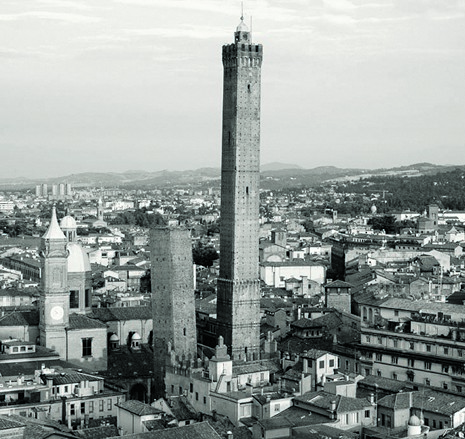
Asinelli Tower, Bologna12th century
Over time, modern high-rise housing began as a response to niche markets for well- appointed and fully-serviced living in residential hotels or similar accommodations. By the late 1930s and particularly into the post-Second World War period, mass provision of housing also assumed a high-rise profile including the production of affordable units. Recently, various forms of residences and hotels have re-appeared, alongside of other hybrids like home-offices, office-hotels, and micro- and macro-residential units. Finally, high-rise living altered or added to the spatial perception available to urban dwellers through panoramic vistas from high-rise apartments and usually with ‘natural’ circumstances held at a distance. This was very different from the middle-ground perspective of ‘being immersed in a landscape’ that was more generally prevalent at the time.
Tall Towers: unit, type and use mixes
Precedents for fully residential tall buildings in New York City began occurring in the 1920s with hotels, including longer-term occupancy residential hotels. The Ritz Tower on Park Avenue at East 57
th
[3]
[4]
[5]
[6]
[7]
[8]
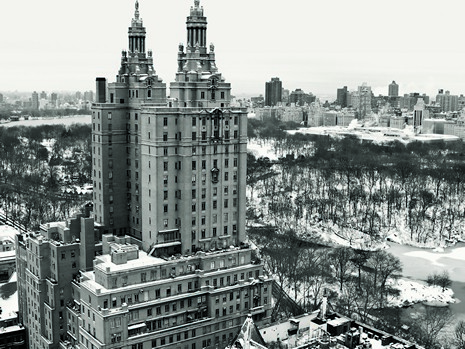
San Remo Tower, New York City
Emery Roth, 1930
By the late 1930s, Shanghai had 35 or more high-rise buildings at or above 10 storeys, a number of which were residential apartments. The Park Hotel overlooking the racecourse by Ladislau Hudec from 1928 was the tallest, at around 28 storeys, and the tallest building in China until the contemporary period. Rising to 22 storeys, Broadway Mansions by Frazer, along with Palmer and Turner, commanded a prominent view of the Bund from its site beside Suzhou Creek, while the Picardie Apartments and Willow Court in the French Concession were only slightly lower at 16 and 13 storeys, respectively.
[9]
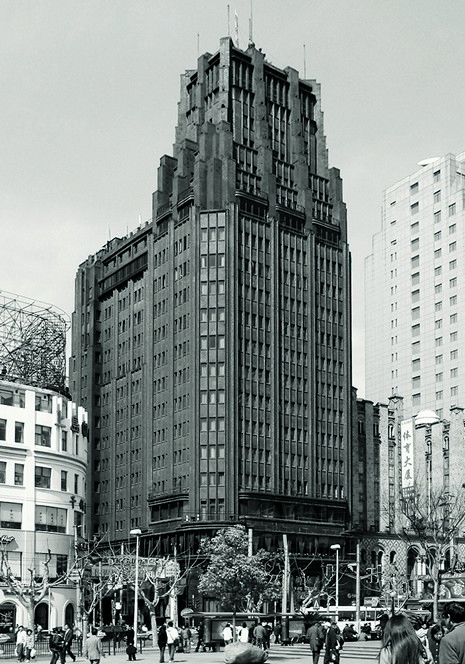
The Park Hotel, Shanghai
Ladislau Hudec, 1928
Architecturally, most were rendered in an
[10]
Away from both New York City and East Asia, an interesting and influential example of high-rise living occurred with Les Gratte-ciel de Villeurbanne, or skyscrapers of Villeurbanne, on the east of Lyon in France between 1930 and 1934. A project mostly by Môrice Leroux, a relatively young architect, it was not without a precedent, given the presence of tall buildings in Francis Chollet’s unbuilt proposal from the Pont Dieux plan of 1926.
[11]
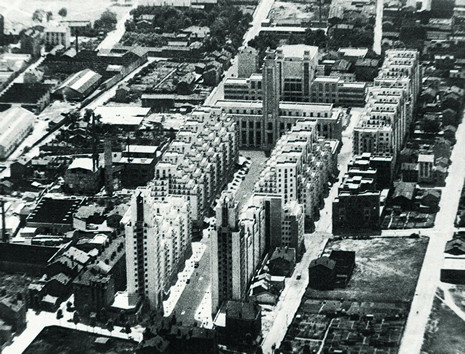
Les Gratte-Ciel de Villeurbanne, Lyon
Môrice Leroux, 1930-34
Villeurbanne was an industrial area that was growing rapidly in Lyon, and a prime mover for the creation of a center to this area, as well as the provision of low- to moderate-income housing, was Lazare Goujon, the socialist mayor from 1924 to 1935.
[12]
During the post-Second World War period, as alluded to earlier, high-rise living also became associated with mass production of units and affordable housing. Two places where this took place on an overwhelming scale were Hong Kong and Singapore during both their attempts to house large numbers of immigrants in public housing estates and to rid the cities of squatter settlements and other inadequate housing.
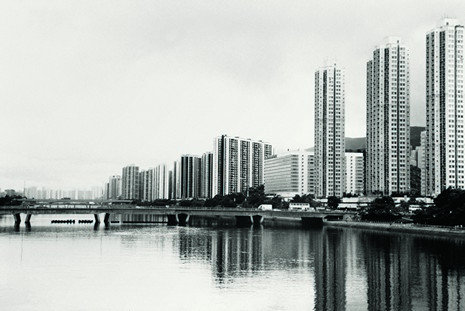
Hong Kong public housing estates
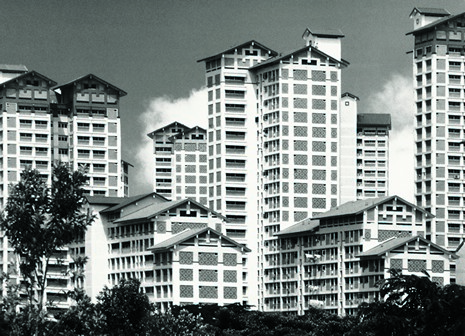
Singapore public housing estates
Poor conditions in refugee camps came to a head in Hong Kong on Christmas Day of 1953 with the Shek Kip Mei fire, when many people were killed and public action to do something about it became aroused. Over the next 50 years or so, a program of public housing provision was mobilized, materially affecting around 70 percent of Hong Kong’s population, starting with the Mark I, eight-storey emergency housing, with little more than two square meters of livable space per person and shared bathroom and kitchen facilities. From then on, public housing rose in height and stature to the 40-floor Concord and Harmony series of towers of the 1980s and ’90s.
[13]
[14]
From the founding of Singapore in 1965 onwards, the city state pursued a policy of collective consumption, whereby publicly-provided housing, married to publicly-run mass transit, allowed labor costs to be written down in a manner that became attractive to industry and other direct foreign investment. Over time, the Ring Concept Plan for the city was solidified through construction of large-scale, high-rise housing estates interlocked with employment and commercial centers through convenient mass transit.
[15]
[16]
th
th
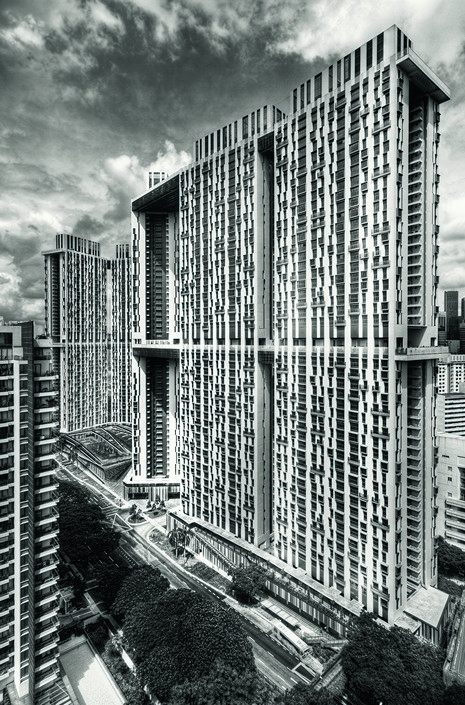
Pinnacle@Duxton, Singapore
ARC Studio Architecture + Urbanism, 2009
Elsewhere, contemporary high-rise housing seems to come in one of two types. The first are what might be termed ‘shapely towers’, with an emphasis on the overall form in the rise of the tower itself, epitomized, for instance, by the circular and outward spiraling form of the Absolute Towers, by MAD in Toronto of 2012.
[17]
[18]
th
[19]
[20]
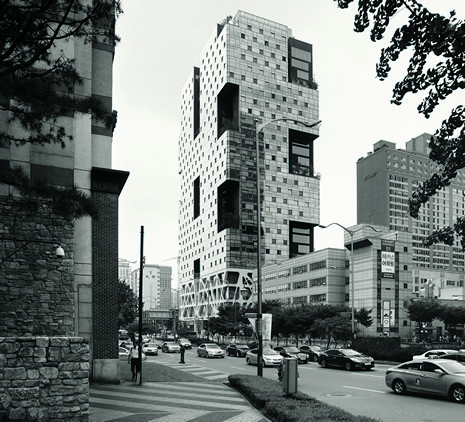
Boutique Monaco “Missing Matrix”, Seoul
Minsuk Cho/Mass Studies, 2008
Tall towers, as mentioned earlier, are typically deployed to accommodate a larger number of dwelling units and population within sites of relatively limited space. Often, such a housing operation is not only expedient in terms of the amount of production based on the aggregation of several basic unit types comprising the floor plan, but also a means of maximizing the returns as well as land value of a particular property development. The cases of interest here are emblematic of how tall towers are utilized in contemporary urban conditions of both high densities and intensities and, at the same time, stand as well-designed projects that have sought to engage with sustainable building and architectural variation. The first is Moulmein Rise, another example from Singapore, completed in 2003, by WOHA Architects, as a private, high-rise condominium for United Overseas Land (UOL) Group Limited. Prior to this project, the local real estate developer had specialized largely in hospitality, before its forays into the commercial and residential sectors. While most of UOL’s initial residential developments were located in the suburban estates in Singapore, Moulmein Rise was its first residential investment in the prime area of Novena, right at the fringe of downtown Singapore, including the core retail district of Orchard Road. In fact, UOL had already begun to establish its presence in Novena, rejuvenating this neighborhood then dominated by offices and both low- and high-rise residences with two mixed-use developments combining office and retail – Novena Square and United Square – that have since become the commercial core of the area. As the local property market took a beating from the Asian Financial Crisis of 1997, UOL acquired a small 0.23-hectare site in the vicinity to be developed into mid- or high-rise housing.
Besides the proximity to both the commercial core at Novena and Orchard Road, the site for Moulmein Rise is just north of a wedge of green area surrounded by low-rise single-family attached dwellings, beyond which lie the presidential grounds. Given this uninterrupted view of the downtown to the south, along with the developer’s desire for a striking high-rise project that would maximize the returns on their investment, a closed competition was held among four architectural firms to obtain the optimal design solution. While the original intention by UOL was for a larger building footprint and a structure that would be lower in height, WOHA’s principals, having won the competition, convinced their clients otherwise. This resulted in a slender, modern, elegant design rising 28 storeys in height that fully leveraged on the views of the surroundings, but also the southern exposure and enhanced cross-ventilation through the smaller footprint and increases in height. With a floor area ratio or plot ratio of 2.8, the project reflects a high intensity of use on the site – a condition commonly found in land-scarce Singapore where at least 79 percent of the city-state’s residential building stock is in the form of high-rises with plot ratios of at least 2.1.
[21]
The most outstanding features of Moulmein Rise, it must be said, was its innovative incorporation of vernacular climate control strategies and expression of architectural variation through a recombination system of simple, standard elements. Located in the hot and humid equatorial region, Singapore is subjected to heavy convectional rains and seasonal monsoons. Therefore, as much as high-rise residences could have benefited from the cooler air higher up, the frequent rains often resulted in closed windows. Having lived in a high-rise public housing unit, Wong Mun Summ, one of WOHA’s principals, was eager to address this untapped ventilation and the entry of precipitation into the buildings by the force of winds from different directions. Moulmein Rise, which was their first large-scale residential project, presented a welcome opportunity to tackle these construction issues. A primary outcome of WOHA’s research was what they called a ‘tropical’ approach to high-rises, including the adoption of monsoon windows framed under the sills of the more conventional bay windows running continuously along the façade. Made of a perforated aluminum screen that sits perpendicular to the glass windows, this sliding panel is operated by a winder, affording natural ventilation into each of the units while also serving as a shelf, even when the glass windows are closed. Due to this inflow of air, particularly at the higher levels, many occupants found that it was no longer necessary to cool their apartments with the energy-consumptive air-conditioners in the evenings.
[22]
In terms of the architectural design, WOHA’s other aspiration was to avoid a simple extrusion of the units upwards, and the creation of what merely would be an urban object. To this end, they strove to endow the façade with some ‘personality’, injecting a degree of variation and complexity such that each apartment would have its own identity. Indeed, from afar, Moulmein Rise stands out for its rhythmic façades. On the south, the two units on each floor are distinguished and expressed materially on the exterior, whereas the units on the west are defined by alternating bands of glass and overhangs, while the units on the east are fenestrated by a seemingly random array of bay windows and planters. On the north, the building is clad in bands of perforated aluminum screens concealing the air-conditioner ledges and drying racks but also serving as sunshading devices. These are displaced marginally on each floor, thereby revealing parts of the circling stairway and monsoon windows while generating a lively, environmental façade. By mixing these three basic elements – the monsoon windows, screens, and planters – in a repetitive, haphazard fashion, and then stacked up vertically in a random order, the architects successfully created visually complex yet engaging façades that doubled up as environmentally sensible curtain walls. Moreover, the extra space taken up by these elements is exempt from development tax but still counts as saleable area, a fact that contributes to the commercial interests of UOL, for the special façade features simultaneously enhance the amenity and value of the apartments. This notion of variation is taken up further and applied to the interiors with the creation of a modular system based on multiples of 0.30 meters that regulate a range of architectural dimensioning, such as floor-to-floor heights.
Within the typical units, the circulation spine bisects the apartments into two halves, with the master bedroom and open living and dining area located to the north for greater privacy, while the two smaller bedrooms and service areas such as the kitchen and bathrooms are located to the south. Flexibility in layout is achieved by the open living area, as well as the potential to combine the two smaller bedrooms as needed. The two penthouses each have a unique layout but generally adhere to the same spatial logic, albeit with larger master bedrooms and double-height open living and dining areas. Space-wise, the two typical units are 120 and 122 square meters, while the penthouses cover an area of 220 and 235 square meters, both of which are relatively commodious. Upon entering the units, there is a continuous flow in the interior, created largely through the circulation spine opening up to views on both the eastern and western ends, as well as across with the open space concept of the living and dining area. With a density of nearly 215 dwelling units per hectare, Moulmein Rise stands as an instance of an innovative, low-energy approach towards tropical, high-rise living, establishing its presence in a high-density urban setting that at the same time expresses a high degree of individuality through the plan and façade variations.
In the North American context, a high-rise project completed recently in 2011 and launched with much fanfare is 8 Spruce Street in New York City, also known as the Beekman Tower or New York by Gehry. Soaring to an impressive height of 267 meters and thus earning the accolade of being the ‘tallest residential tower in the western hemisphere’ at the time of its completion, this iconic addition to the Manhattan skyline was designed by Frank Gehry & Partners.
[23]
[24]
[25]
th
[26]
Besides the 9,290-square-meter public school, later named the Spruce Street School, the final design for the skyscraper also housed below-grade hospital parking, ground floor retail, a 2,323-square-meter ambulatory care center operated by the Hospital, residential amenities like a grilling terrace, swimming pool, fitness center, library, and children’s playroom on parts of the sixth to eighth floors, and a total of 903 rental units. These programs are stacked vertically on a T-shaped pedestal, creating a gradual zone of transition between the first and ninth floors from public to semi-private, and finally private space. This public/private differentiation is also expressed architecturally, with the five-storey podium of public programs clad in nondescript red bricks with at least double-height floors, beyond which the elaborate stainless-steel form of the residential tower and its communal amenities rises up to dizzying heights on the 76
th
The soaring tower accommodating an impressive density of approximately 2,258 dwelling units per hectare asserts a remarkable presence among the bevy of high-rise beauties with its arresting, silky finish. Supposedly inspired by the ‘hard folds’ of Bernini and the ‘soft folds’ of Michelangelo, Gehry and his office designed an eye-catching façade that draped delicately over the angular T-shaped volumes, generating a masterful illusion of movement activated by the play of light and shadows upon the gentle ripples across the surface. To realize this unique, undulating form, Permasteelisa North America, a long-time collaborator of Gehry’s since 1992 when they created the Barcelona Fish sculpture, was brought into the design-assist phase. The façade was installed using a unitized curtain wall system, where rain screen panels of varying radii were fabricated to be attached to corresponding flat unitized curtain wall panels through interlocking male-female mullions and a mating horizontal stack. These rain screen panels producing the folds can curve out between six inches to six feet, and with a steel angel hair finish to diffuse light and reduce glare from the surface, the façade attains a visual softness and exuberance.
[27]
nd
rd
th
th
th
st
th
[28]
Another recent project of note from North America is The Contemporaine by Perkins+Will, located in the River North area of Chicago on a modest 0.08-hectare site. Completed earlier in 2004, the 15-storey-tall building is situated in a neighborhood with an eclectic mix of redundant and converted warehouses, water towers, low-rise commercial and new high-rise dwellings that were developed in response to then Mayor Richard M. Daley’s interest in the rapid development of the city’s downtown core. The Contemporaine is composed of a level of retail on the ground floor along with the entry lobby, three floors of parking stacked above, and 11 floors of apartments and penthouses floating on top of this podium. Constructed with cast-concrete floors supported by slender columns, the building is clad in glass from floor to ceiling, thereby affording a high degree of transparency to the structural and material elements in this contemporary, poetic composition that clearly pays tribute to Le Corbusier and the modernist movement. Variation on the façade was cleverly achieved by reversing the orientation of every other window frame, creating a “Mondrian-esque mullion pattern”.
[29]
[30]
High-rise provision of housing, particularly in contemporary times, often involves the balancing of particular requirements and general trends. For instance, in many if not most cultural and social settings, entry and elevator services for residents are separated from those serving other functions that may be in a high-rise building, including office commercial and retail commercial. This is done for the purposes of security, maintenance, and even the exclusivity of a particular address. Nevertheless, recent and not so recent trends towards integration of a variety of different uses in residential and other building complexes have also been influential, raising questions about degrees and kinds of proximity between strictly residential uses and other functions, especially those on the ‘community service’ side of non-residential use. Of course, solutions can and have been found allowing for reasonable and creative parsing of exclusivity with integration, although it often involves at least a separation of residential from office commercial functions, except when home-offices and hotel-offices are predominant functions. Even then, either the domicile or office aspect tends to dominate in any particular complex.
Another aspect that requires balance involves effective and reasonable discrimination of variance among unit types, unless some form of unbridled variation is provided in a cost-effective manner that is endemic to a systematic property of building construction, as in the case at 8 Spruce Street, or the cutouts in Boutique Monaco. Even then, there needs to be something more on offer than simply difference for difference’s sake. One potential aspect and advantage of high-rise housing is a capacity to vary units in both plan and section throughout the rise of the building. Several examples discussed here do just that and provide for different household formations, economic means, and lifestyle requirements.
Yet another aspect of high-rise housing that requires consideration and balancing towards potentially productive outcomes concerns obsolescence and the maintenance of resilience to changes in markets and lifestyle conditions. Towers, unlike smaller and more singular dwelling units and types, tend to lock-in units in manners that often prove difficult and expensive to retrofit. Broadly applicable decisions in some settings, like in China and elsewhere now and in the past to limit sizes and varieties of units, particularly to the lower end of usable space standards, can induce rapid obsolescence when market and related circumstances change for the better, with substantial associated social costs. In effect, buildings quickly become moribund and can only be replaced. By contrast, contemporary trends towards keeping building façades free for habitable spaces and concentrating necessary structure in compact cores and external structure, together with space-saving mechanical systems, can provide for more fully-flexible layouts of dwelling units. Although these units may not change rapidly, depending upon the tenancy and ownership involved, they can technically be altered well inside the life span of the overall building structure and services. Finally, manners of appreciating the verticality of high-rise living, including the views on offer, appear to have broadened into the contemporary era, including multiple choices of balconies, roof garden orientations, community sky decks, and variations in façade treatments according to insolation and visual prospects. In most cases, these are net positive outcomes helping to rebalance tall housing against the prevalent uniformity of some former eras.
Footnotes
Theodore Turak, William Le Baron Jenney: A Pioneer of Modern Architecture (Ann Arbor, M.I.: UMI Research Press, 1986).
Rosella Vantaggi, San Gimignano: Town of Fine Towers (Milan: Phingraf, 1979).
Robert A. M. Stern, Gregory Gilmartin, and Thomas Mellins, New York 1930: Architecture and Urbanism Between the Two World Wars (New York: Rizzoli, 1987), 212–215.
Stern et al., New York 1930, 214–215.
Hugh Ferriss, The Metropolis of Tomorrow (Princeton, N.J.: Princeton Architectural Press, 1986); and Dennis Sharp, ed., Alfred C. Bossom’s American Architecture, 1903–1926 (London: Book Art, 1984).
Richard Plunz, A History of Housing in New York City: Dwelling Type and Social Change in the American Metropolis (New York: Columbia University Press, 1990), 194–195.
Plunz, A History of Housing in New York City, 195–196.
Plunz, A History of Housing in New York City, 196–200.
Edward Denison and Guang Yu Ren, Building Shanghai: The Story of China’s Gateway (Hoboken, N.J.: Wiley-Academy, 2006), 128–193.
Chisong Qu, Gemischtfunktionale Hochhäuser in China und Deutschland (TU Darmstadt: Fachbereich Architektur, 2003).
Anne-Sophie Clémençon, Les Gratte-Ciel de Villeurbanne (Besançon: Editions de l’Imprimeur, 2004).
Clémençon, Les Gratte-Ciel de Villeurbanne.
Manuel Castells, L. Goh, and R. Y-W Kwok, The Shek Kip Mei Syndrome: Economic Development and Housing in Hong Kong and Singapore (London: Pion, 1990).
Peter G. Rowe, “Hong Kong – New Territories, New Towns,” Arbitare 450 (May 2005): 118–125.
Constance Mary Turnbull, A History of Singapore, 1819–1988 (Singapore: Oxford University Press, 1989), 288–327; and Giok Ling Ooi, “Singapore’s Changing International Orientations: 1960–1990,” in Singapore from Temasek to the 21st Century: Reinventing the Global City, ed. Karl Hack and Jean-Louis Margolin, with Karine Delaye (Singapore: NUS Press, 2010), 323–344.
David Cohn, “ARC Plans Mega-Structure for Singapore,” World Architecture 108 (July-August 2002): 19–24.
Matteo Poli, “MAD Absolute Towers: Mississauga,” Arbitare 527 (2012): 42–49.
Aurora Fernández Per, Javier Mozas, and Javier Arpa. DBook: Density, Data, Diagrams, Dwellings: A Visual Analysis of 64 Collective Housing Projects (Vitoria-Gasteiz: a+t ediciones, 2007), 344–349.
Michele Costanzo, MVRDV: Works and Projects, 1991–2006 (Milan: Skira, 2006), 158–167.
“Boutique Monaco,” Space 491 (October 2008): 76–91.
“Minister Mah launches Draft Concept Plan 2001 Exhibition,” Urban Redevelopment Authority, April 28, 2001, accessed October 26, 2013, http://www.ura.gov.sg/pr/text/pr01-20.html
Aga Khan Award for Architecture, “Moulmein Rise Residential Tower, Singapore” in Intervention Architecture: Building for Change (London: I. B. Tauris & Co Ltd., for the Aga Khan Award for Architecture, 2007), 102.
“Building”, New York by Gehry, accessed October 27, 2013, http://www.newyorkbygehry.com/#!new-york-by-gehry
David Dunlap, “Tower Would Create Residences, And Space for Pace University,” New York Times, April 20, 2004, accessed October 27, 2013, http://www.nytimes.com/2004/04/20/nyregion/tower-would-create-residences-and-space-for-pace-university.html
David Dunlap, “Pace Pulls Out of Expansion Project, Citing Builder’s Price Increase,” New York Times, November 4, 2004, accessed October 27, 2013, http://www.nytimes.com/2004/11/04/nyregion/04pace.html?_r=0
“HDC Board Approves Financing for Two Major Projects,” NYC HDC, accessed October 27, 2013, http://www.nychdc.com/pages/pr_02%252d27%252d20081.html
“8 Spruce Street”, accessed October 27, 2013, http://ominy.org/media/projects/Spring11_8Spruce_web.PDF
Pippo Ciorra and Marco Biagi, “Beekman Tower, New York,” Casabella 797 (January 2011): 8–19.
Meghan Drueding et al., “Residential Architect Design Awards ’05: Project of the Year – Contemporaine, Chicago,” Residential Architect (May 2005): 42.
Drueding et al., “Residential Architect Design Awards ’05: Project of the Year – Contemporaine, Chicago,” 42.
Internal Links
Originally published in: Peter G. Rowe, Har Ye Kan, Urban Intensities: Contemporary Housing Types and Territories, Birkhäuser, 2014.